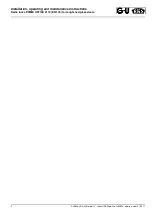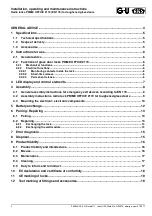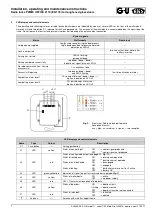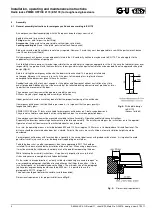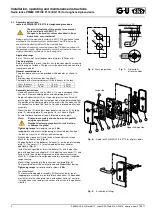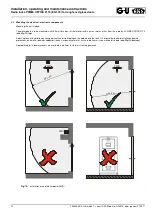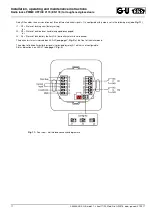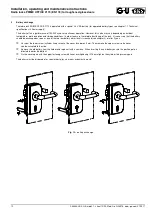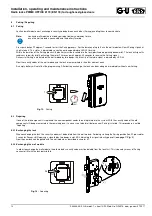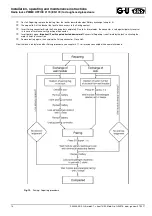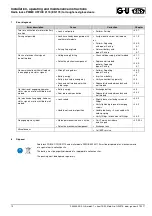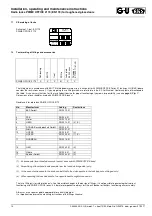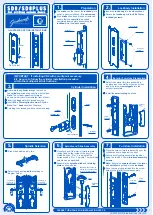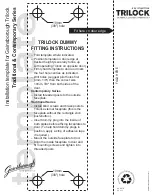
Installation, operating and maintenance instructions
Radio locks PRIME OFFICE 2170 (EN 179) for toughened glass doors
16
0-45648-3E-0-GB, modif. 1, sheet 16/20, Mod. No. G24578, www.g-u.com 01/2011
9
Product liability
According to the defined manufacturer's liability described in the German "Product Liability Act", the following information regarding exit
devices should be observed.
Non-compliance excempts the manufacturer of his liability.
9.1
Product liability and intended use
A lock generally has the function to keep a door shut, and to lock it.
'Keeping shut' means preventing a door from being opened by pulling or pushing, whereas it can be released by operating a lever.
'Locking' means securing a door pulled shut by means of a solid bolt which is ejected from the lock in order to engage in the appropriate
counterpart, i.e. the strike.
The latch is designed to keep the door shut.
The deadbolt is the designed to keep the door locked.
A latchbolt unites both the shutting and the locking function.
A lock must be designed in such a way that the deadbolt can be blocked in locking position, and that door opening without appropriate
opening means is impeded.
Cylinder attachment screws not matching with the backset dimension of the lock must be cut to length (G.U-BKS deliver the appropriate screw
length if the backset is specified in the order).
A glass door lock is a lock which is attached to an appropriate all-glass (toughened glass) swing panel.
Use as intended can only be ensured if locks are combined with approved fittings, locking means (e.g., keys, cylinders), and accessories (e.g.
strike plates), and on condition that installation and maintenance are performed in compliance with the instructions and applicable (DIN)
regulations.
Locks for doors with special functions must comply with applicable regulations and, if required, be marked accordingly. In the case of panic
locks in escape and rescue routes, the handle must not be operated whilst using the key.
Locking cylinders may only be installed in locks without any reservation if they comply with a dimensional standard (e.g. DIN 18252), and if the
locks in turn are explicitly designed for cylinders to this standard.
In all other cases, the manufacturer, dealer, fabricator or consumer of such locks has to ensure that the locking cylinders he has selected are
suitable for use as intended.
It is necessary that legal regulations should be observed.
All general terms and definitions, unless explained in our catalogues or pictures, can be found in the standards for door locks DIN 18250,
DIN 18251-1, DIN 18252, and in the standards for fittings.
Door panel dimensions and weights:
Panel width: max. 1500 mm
Panel height: max. 3500 mm
Panel weight: max. 200 kg
The dimensions and weights referred to above apply to the locking system exclusively!
Please be aware that the maximally permitted dimensions and weights of other door components may be smaller!
9.2
Misuse
Incorrect use – meaning not used as specified – of exit devices is, when for example
- the flawless use is prevented by inserting foreign and/or unintended objects into the lock or into the strike,
- the exit device is manipulated in a such way as to involve structural or functional changes or in any other way not expressly permitted in the
assembly instructions,
- the ejected latchbolt or deadbolt is used to keep the door open,
- exit device components cannot function properly as a result of improper installation or subsequent treatment such as, e.g., painting,
- unintended loads beyond normal hand force are applied to the handle (e.g., lifting and carrying the door by the handle, ramming or kicking
the handle),
- inappropriate locking means are used (e.g., wrongly dimensioned keys, wrongly adjusted bolts),
- the specified door gap changes as a result of hinge re-adjustments or unintended lowering of the door,
- a double door is opened by the passive leaf although not designed and approved for this feature,
- objects or extremities are put between the door leaf and the jamb as the door closes,
- handle and cylinder are operated simultaneously.

